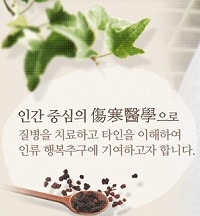 ISSN : 2287-8696
ISSN : 2287-8696
Two Cases of Hyperhidrosis treated by Gyejigajagyak-tang based on Shanghanlun Provisions
Abstract
- keywords
- Gyejigajagyak-tang, Shanghanlun, Hyperhydrosis
Reference
1.Moon JJ, Ahn GS, Kim SH, Park WS, Song MD, Park JH, Kim DH, Kim SW, Choi DY, Shin YI, Ji GY, Shin SW, Ha GT, Lee SG, Kim JB, Lee GG, Kim YM. Interpretation of Shanhanlun. Haneuimunhwasa. 2010:104-7,530,540.
2.Kim EH, Park JH. A study on building a database of prescription and herbs on the Shanghanlun. Journal of East-West medicine. 2010;35(4):17-23.
3.Feng SR. The Six Meridians and prescription-symptoms of Shanghanlun. Seoul. Omniherb. 2012;6:529.
4.Chen FG, Chen FJ, Jong MS, Tsai HL, Wang JR, Hwang SJ. Modern use of Chinese herbal formulae from Shang-Han Lun. Chinese Medical Journal. 2009;122(16):1889-93.
5.Otsuka G. Explanation of Shanhanlun. Euibang publish. 2004;38-9,72-4.
6.Park KM, Choi SH. The comparative study of Sanghanron and hwangjenaegyeong through historical study on Gangpyung·Sanghanron. J. Korean Medical Classics. 1995;9:263-300.
7.Lee SI. A philological research on the way of medical study of Shanghanlun. Official Journal of The Korean Medicine Society For The Herbal Formula Study. 2014;22(2):1-13.
8.Lee SI. Comparison of Shanghanlun. Seoul:KMediACs publishing house. 2015:24,28,203.
9.Shin YJ, Kim YH, Yang HJ, Lee JW. Review of the clinical evaluation of hyperhidrosis. Korean Journal of Orient. Int. Med. 2015:143-56.
10.Lee SJ, Lim JE. A diagnostic system and clinical application based on Shanghanlun six meridian patterns and provisions. Seoul:KMediACs publishing house. 2013.
11.Moon KS. A study on the classification of the misinterpretations about Chinese bronze characters. Journal of regional culture research. 2013;12:181-218.
12.Lee SH, Baek JH. A review of Korean medicine treatment for hyperhidrosis. J. Pediatr Korean Med. 2019;33(3):42-55.
13.Rho YB, Lee GJ, Lee JH. A study of dietetic therapy on the edema. Korean Medical Association of Clinical Sanghan-Geumgwe. 2016;8(1):145-53.
14.Park SY. A case report of hyperhidrosis treated by Oryeong-san based on Shanghanlun provisions. Korean Medical Association of Clinical Sanghan-Geumgwe. 2018;10(1):133-42.
15.Park SD, Shin SW, Park JH. The study on the Donhwang Manuscript Sanghallon. J. Korean Medical Classics. 2008;21(1):27-42.
16.Chinese etymology. 堅, 因, 爾. retrieved 2020 Dec 10. Available URL :https://hanziyuan.net/#home
17.Ha YS. Hanjaeowonsajeon. Doseochulpan3. 2015:45.
- Downloaded
- Viewed
- 0KCI Citations
- 0WOS Citations

